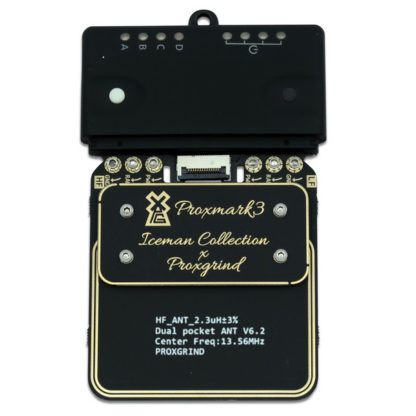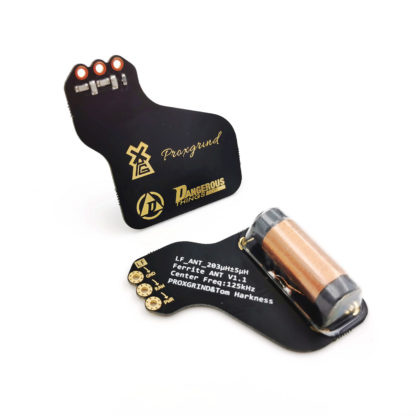PROXMARK3 RDV4
The Proxmark is a powerful ![]() but not particularly user-friendly
but not particularly user-friendly ![]() device.
device.
This Wiki has been put together to provide an easy to read and understand HOW TO.
The commands have been thinned out to the more relevant.
FIRMWARE UPGRADE
FIRMWARE UPGRADE * Ensure your proxmark is flashed to the latest Firmware
GENERIC HARDWARE COMMANDS
hw
When in doubt of how to use a command, try the command with an h after it to see if it has a help. ![]()
Some commands are available only if a Proxmark is actually connected. Check column “offline” for their availability.
| command | offline | description |
|---|---|---|
| hw tune | Y | Tunes the antenna and should be performed every time the Proxmark is flashed |
| hw help | Y | This help |
| hw reset | N | Reset the Proxmark3 |
| hw version | N | Show version information about the connected Proxmark |
| help | Y | This help. Use ’ help’ for details of a particular command. |
| quit | Y | Exit program |
| exit | Y | Exit program |
LOW FREQUENCY
lf
.
Dangerous Things lf Antenna
Dangerous things Low-Frequency Antenna
Designed exclusively for use with the proxmark3 rdv4, this 125kHz “LF” antenna is so powerful, it can talk to our 125kHz implants like the xEM and NExT from 2cm away! It’s even so powerful it can even talk to the xEM while it is still inside the injection assembly needle! GET IT!
.
lf generic commands
| command | offline | description |
|---|---|---|
| lf help | Y | This help |
| lf config | N | Set config for LF sampling, bit/sample, decimation, frequency |
| lf read | N | [‘s’ silent] Read 125/134 kHz LF ID-only tag. Do ‘lf read h’ for help |
| lf search | Y | [offline 1 or 0] [‘u’] Read and Search for valid known tag (in offline mode it you can load first then search) - ‘u’ to search for unknown tags |
.
t55XX ( xEM, NExT )
| command | offline | description |
|---|---|---|
| lf t55xx help | Y | This help |
| lf t55xx bruteforce | Y | [i <*.dic>] Simple bruteforce attack to find password |
| lf t55xx config | Y | Set/Get T55XX configuration (modulation, inverted, offset, rate) |
| lf t55xx detect | N | [1] Try detecting the tag modulation from reading the configuration block. |
| lf t55xx p1detect | N | [1] Try detecting if this is a t55xx tag by reading page 1 |
| lf t55xx read | N | [password] – Read T55xx block data (page 0) [optional password] |
| lf t55xx write | N | b d p [password] [t] [1] – Write T55xx block data ([1] for page 1) |
| lf t55xx trace | N | [1] Show T55xx traceability data (page 1/ blk 0-1) |
| lf t55xx info | N | [1] Show T55xx configuration data (page 0/ blk 0) |
| lf t55xx dump | N | [password] Dump T55xx card block 0-7. [optional password] |
| lf t55xx wipe | N | [q] Wipe a T55xx tag and set defaults (will destroy any data on tag) |
.
EM4X ( xEM, NExT )
| command | offline | description |
|---|---|---|
| lf em help | Y | This help |
| lf em 410xread | N | [clock rate] – Extract ID from EM410x tag in GraphBuffer |
| lf em 410xdemod | Y | [findone] – Extract ID from EM410x tag (option 0 for continuous loop, 1 for only 1 tag) |
| lf em 410xsim | N | – Simulate EM410x tag |
| lf em 410xwatch | N | [‘h’] – Watches for EM410x 125/134 kHz tags (option ‘h’ for 134) |
| lf em 410xspoof | N | [‘h’] — Watches for EM410x 125/134 kHz tags, and replays them. (option ‘h’ for 134) |
| lf em 410xwrite | N | <‘0’ T5555> <‘1’ T55x7> [clock rate] – Write EM410x UID to T5555(Q5) or T55x7 tag, optionally setting clock rate |
| lf em 4x05dump | N | – Read all EM4x05/EM4x69 words |
| lf em 4x05info | N | – Read and output EM4x05/EM4x69 chip info |
| lf em 4x50read | Y | Extract data from EM4x50 tag |
.
HITAG (xHT)
| command | offline | description |
|---|---|---|
| lf hitag help | Y | This help |
| lf hitag list | N | List Hitag trace history |
| lf hitag reader | N | Act like a Hitag Reader |
| lf hitag sim | N | Simulate Hitag transponder |
| lf hitag snoop | N | Eavesdrop Hitag communication |
| lf hitag writer | N | Act like a Hitag Writer |
| lf hitag simS | N | <hitagS.hts> Simulate HitagS transponder |
| lf hitag checkCallenges | Y | <challenges.cc> test all challenges |
.
HID
| command | offline | description |
|---|---|---|
| lf hid help | Y | This help |
| lf hid demod | Y | Demodulate HID Prox from GraphBuffer |
| lf hid read | N | [‘1’] Realtime HID FSK demodulator (option ‘1’ for one tag only) |
| lf hid sim | N | – HID tag simulator |
| lf hid clone | N | [‘l’] – Clone HID to T55x7 (tag must be in antenna)(option ‘l’ for 84bit ID) |
.
INDALA
| command | offline | description |
|---|---|---|
| lf indala help | Y | This help |
| lf indala demod | Y | [clock] [invert<0 |
| lf indala read | N | Read an Indala Prox tag from the antenna |
| lf indala clone | N | [‘l’] – Clone HID to T55x7 (tag must be in antenna)(option ‘l’ for 84bit ID) |
| lf indala altdemod | T | [‘224’] – Alternative method to Demodulate samples for Indala 64 bit UID (option ‘224’ for 224 bit) |
HIGH FREQUENCY
hf
.
hf Generic commands...
| command | offline | description |
|---|---|---|
| hf help | Y | This help |
| hf tune | N | Continuously measure HF antenna tuning |
| hf list | Y | List protocol data in trace buffer |
| hf search | Y | Search for known HF tags (identifies 14443a, 14443b, 15693, iClass) |
.
NTAG 203, 213, 215, 216
NTAG 203, 213, 215, 216
| command | offline | description |
|---|---|---|
| hf mfu help | Y | This help |
| hf mfu dbg | N | Set default debug mode |
| hf mfu info | N | Tag information |
| hf mfu dump | N | Dump Ultralight / Ultralight-C / NTAG tag to binary file |
| hf mfu rdbl | N | Read block |
| hf mfu wrbl | N | Write block |
| hf mfu setuid | Y | Set UID - MAGIC tags only |
.
Mifare ( xM1 )
I recommend you follow this guide
| command | offline | description |
|---|---|---|
| hf help | Y | This help |
| hf mf csetuid | N | Set UID for magic Chinese card |
| hf mf csetblk | N | Write block - Magic Chinese card |
| hf mf cgetblk | N | Read block - Magic Chinese card |
| hf mf cgetsc | N | Read sector - Magic Chinese card |
| hf mf cload | N | Load dump into magic Chinese card |
| hf mf csave | N | Save dump from magic Chinese card into file or emulator |
Mifare WIKI
How can I read a card contents?
hf mf rdbl 0 a ffffffffffff0: block numbera: key typeffffffffffff: key
hf mf rdsc 0 a ffffffffffff0: sector numbera: key typeffffffffffff: key
How can I write a block into a card?
- ‘hf mf wrbl 0 a ffffffffffff 000102030405060708090a0b0c0d0e0f’, where 0 - block number, a - key type, ffffffffffff - key,
000102030405060708090a0b0c0d0e0f - block data.
How can I break a card?
- ‘hf mf mifare’
if it doesn’t found a key: ‘hf mf mifare XXXXXXXX’ , where XXXXXXXX - Nt from previous run
‘hf mf nested 1 0 a FFFFFFFFFFFF’, where 1 - card type MIFARE CLASSIC 1k, FFFFFFFFFFFF - key that found at previous step.
How to save emulator dump from a card
- ‘hf mf mifare’
- if it doesn’t found a key: ‘hf mf mifare XXXXXXXX’ , where XXXXXXXX - Nt from previous run
- ‘hf mf nested 1 0 a FFFFFFFFFFFF t’, where 1 - card type MIFARE CLASSIC 1k, FFFFFFFFFFFF - key that found at previous step.
- ‘hf mf efill a FFFFFFFFFFFF’
- ‘hf mf esave filename’
How to emulate a card
- ‘hf mf mifare’
- if it doesn’t found a key: ‘hf mf mifare XXXXXXXX’ , where XXXXXXXX - Nt from previous run
- ‘hf mf nested 1 0 a FFFFFFFFFFFF t’, where 1 - card type MIFARE CLASSIC 1k, FFFFFFFFFFFF - key that found at previous step.
- ‘hf mf efill a FFFFFFFFFFFF’
- ‘hf mf sim’
How to emulate a new card
- ‘hf mf eclr’
- ‘hf mf sim’
How to emulate a card with help of dump from file
- ‘hf mf eload filename’, where filename - dump’s file name (.eml)
- ‘hf mf sim’
How to have look at the emulator memory
- ‘hf mf eget 00’, where 00 - block number from 0 to 0x63. Each block contains 16 bytes of memory.
How to make changes into the emulator memory
- ‘hf mf eset 01 000102030405060708090a0b0c0d0e0f’,
where: - 00 - block number from 0 to 0x63. Each block contains 16 bytes of memory.
- 000102030405060708090a0b0c0d0e0f - block data.
.
.

